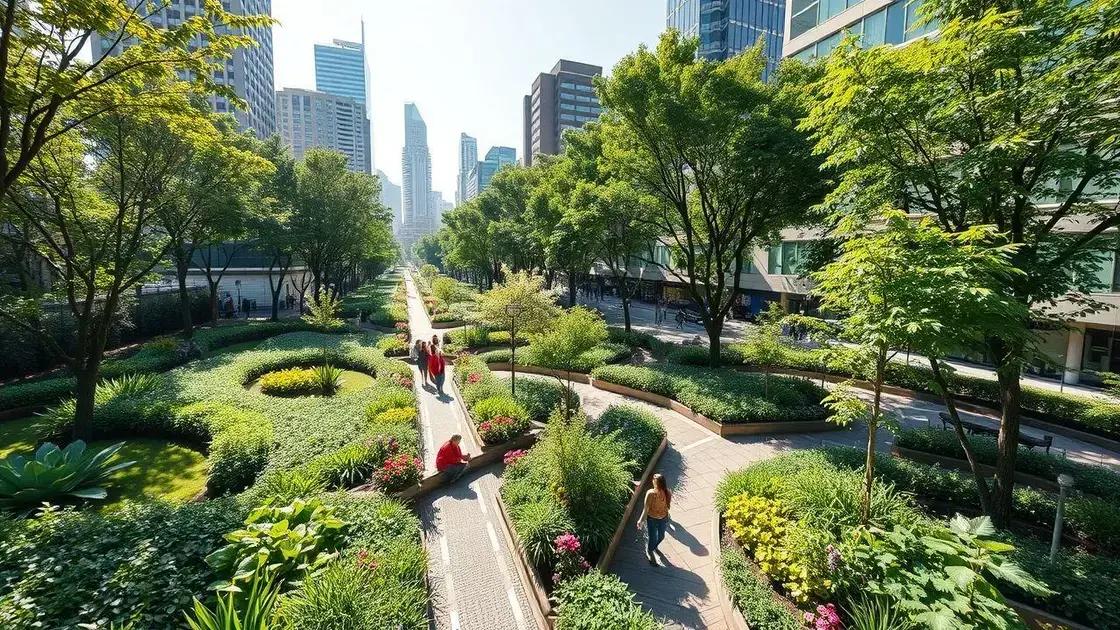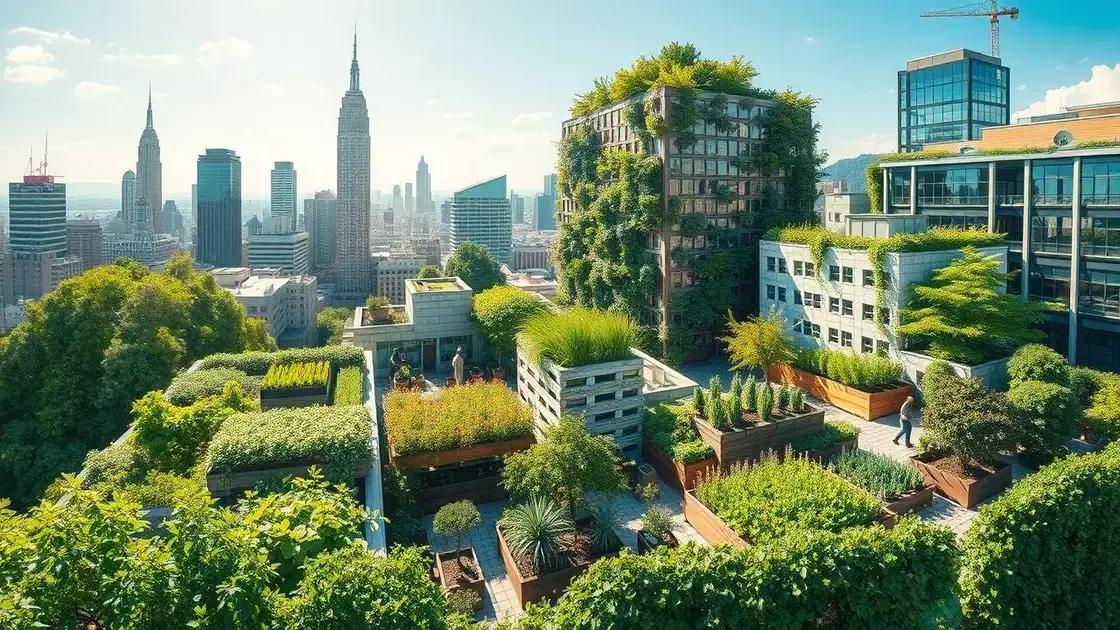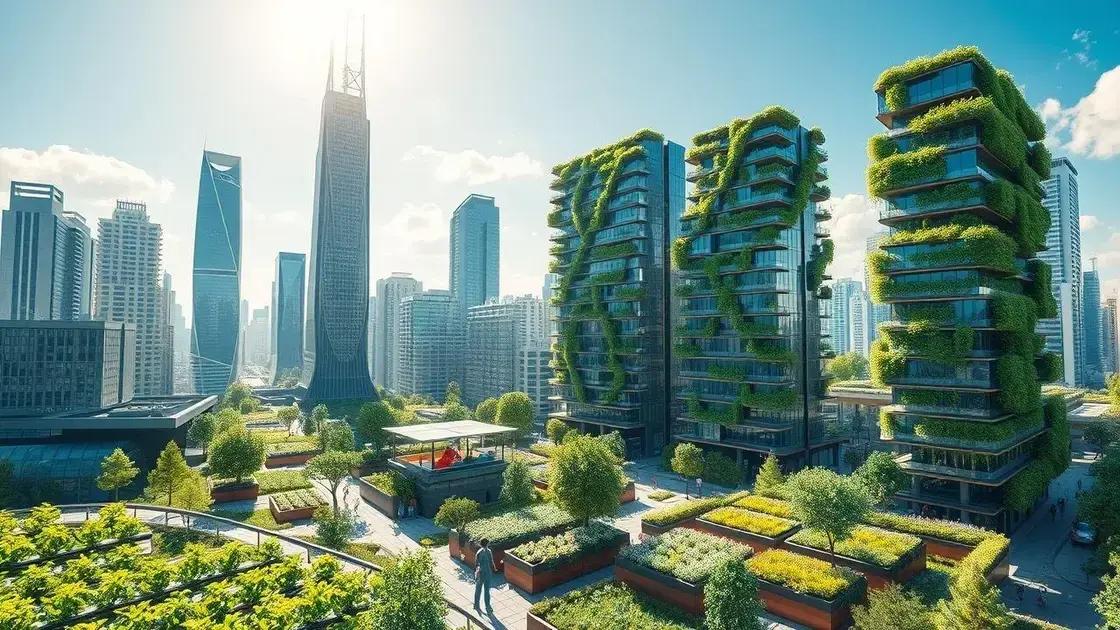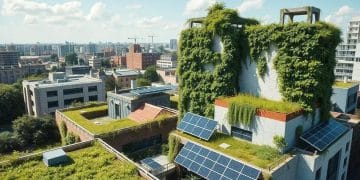Green infrastructure headlines trends: what’s emerging now

Green infrastructure is an urban planning approach that integrates natural systems to enhance sustainability, manage stormwater, improve air quality, and create livable communities while reducing the impacts of climate change.
Green infrastructure headlines trends are shaping the way we think about sustainable living. Ever wondered how cities enhance their resilience while improving our quality of life? Let’s dive into the exciting innovations that are taking root.
Understanding green infrastructure
Understanding green infrastructure is key to creating sustainable urban environments. This approach integrates nature into urban planning. It helps cities manage stormwater, reduce heat, and improve air quality. But what does this really mean for our communities?
First, let’s look at some important aspects of green infrastructure:
Components of Green Infrastructure
Green infrastructure includes various elements that work together to provide benefits. Key components are:
- Green roofs that absorb rainwater and provide insulation
- Rain gardens that filter stormwater and attract wildlife
- Permeable pavements for better water drainage
- Urban forests that improve air quality and provide shade
These features not only enhance the environment but also foster community well-being. For instance, parks and natural spaces can improve mental health and encourage social interaction.
Benefits for Cities
Cities implementing green infrastructure see a myriad of benefits. These can include:
- Reduced urban flooding during heavy rains
- Lower energy costs due to shade and insulation
- Increased property values as neighborhoods become more attractive
Moreover, green infrastructure can create jobs in landscape design, maintenance, and construction. This helps to strengthen the local economy while benefiting the environment.
Essentially, investing in green infrastructure is investing in a sustainable future. It encourages resilience against climate change while creating vibrant communities.
Key trends driving green infrastructure

Key trends driving green infrastructure are reshaping our cities and their environments. As urban areas grow, the need for sustainable solutions is more critical than ever. These trends help conserve resources and enhance the quality of life for residents.
One significant trend is the increasing focus on nature-based solutions. Instead of traditional concrete methods, cities are turning to more eco-friendly options. This approach allows for better management of water while also providing beautiful landscapes.
Emerging Practices
New practices in green infrastructure are gaining attention:
- Utilization of green roofs to reduce heat and manage stormwater
- Creation of urban woodlands to enhance biodiversity and absorb carbon
- Implementation of bioswales for efficient water drainage and quality improvement
In addition, there is a rise in community engagement surrounding green initiatives. Residents are taking an active role in creating green spaces, making cities more inclusive. This trend not only supports environmental goals but also fosters a sense of community.
Policy Changes and Innovations
Policies that support green infrastructure are on the rise globally. Many governments are providing incentives for projects that implement sustainable practices. These include financial backing for green development and stricter regulations on urban sprawl.
Moreover, technology is revolutionizing how green infrastructure is designed and maintained. Innovations such as smart irrigation systems and drone monitoring are being employed to optimize resources. This ensures that solutions are not only effective but also efficient and sustainable.
As these key trends continue to evolve, they promise to create cities that are not only more resilient but also vibrant and livable spaces for all.
Case studies of successful green infrastructure
Case studies of successful green infrastructure can offer valuable insights into practical applications and benefits. By examining real-world examples, we can understand how cities leverage nature to solve pressing urban challenges.
One standout case is New York City’s High Line. This elevated park transformed an unused railway into a vibrant green space. It shows how repurposing infrastructure can boost local economies and provide recreational areas for residents and visitors alike.
Other Notable Examples
Several cities around the globe have implemented impressive green infrastructure:
- Chicago: The city installed green roofs on many buildings to reduce energy costs and improve stormwater management.
- Portland: This city utilizes bioswales and rain gardens throughout its neighborhoods, effectively managing excess rainwater while enhancing community aesthetics.
- Singapore: Known for its vertical gardens and green buildings, Singapore promotes biodiversity and sustainability in its urban planning.
These examples highlight the versatility of green infrastructure. They illustrate that such projects can be tailored to fit specific urban needs while also improving residents’ quality of life.
Community Involvement
Another critical aspect of these case studies is community involvement. Cities that engage their residents in planning and maintenance often see greater success. Community gardens, for example, create a sense of ownership and responsibility among participants.
In addition, these projects often provide educational opportunities regarding sustainability and the environment. Schools and local organizations partner with city planners to create interactive experiences that foster appreciation for green infrastructure.
As we see more cities adopt these principles, the positive outcomes become evident. Residents enjoy better air quality, reduced heat effects, and beautiful spaces to connect with nature.
Future prospects for urban sustainability

Future prospects for urban sustainability are shaping how we think about cities. As population densities increase, urban areas must adapt to become more livable and resilient. The approach toward sustainability is evolving, encouraging cities to integrate nature more effectively.
One major trend is the push for smart cities. These urban areas use technology to improve infrastructure and services. For instance, smart sensors can manage energy use in real-time, optimizing resources and reducing waste.
Innovative Solutions
Cities are also exploring innovative solutions to enhance sustainability:
- Vertical farms that allow food production within urban settings, reducing transportation emissions.
- Urban heat mitigation strategies that involve planting more trees and creating green spaces.
- Enhanced public transportation systems to reduce reliance on personal vehicles, cutting down on pollution.
Technology and nature are coming together to create effective plans. Cities are seeing the benefits of integrating green spaces into daily life. This not only improves air quality but also provides residents with areas for recreation and relaxation.
Collaboration and Community Engagement
Future urban sustainability also hinges on collaboration. Local governments, businesses, and residents must work together. Community input is vital in the planning process. Engaged citizens can help shape sustainable initiatives that meet their needs and desires.
Education plays a crucial role in this collaboration. When residents understand the benefits of sustainability, they are more likely to invest in green practices. This knowledge nurtures a culture of sustainability that can thrive and evolve.
Ultimately, as cities embrace future prospects for urban sustainability, they will become more resilient, equitable, and greener. This transformation is essential for addressing climate challenges while enhancing the quality of life for all citizens.
FAQ – Frequently Asked Questions about Green Infrastructure and Urban Sustainability
What is green infrastructure?
Green infrastructure refers to an approach that incorporates natural processes and systems into urban planning. It aims to manage stormwater, improve air quality, and enhance urban landscapes.
How can communities participate in green infrastructure projects?
Communities can get involved by engaging in local planning discussions, volunteering for maintenance of green spaces, and promoting sustainability initiatives in their neighborhoods.
What are the benefits of implementing smart technologies in urban sustainability?
Smart technologies enhance efficiency by optimizing resource use, reducing waste, and improving service delivery in urban areas, leading to a more sustainable environment.
How do successful case studies influence future green initiatives?
Successful case studies provide models for cities to follow, demonstrating the benefits and feasibility of green infrastructure solutions, which can inspire further investment and community support.





